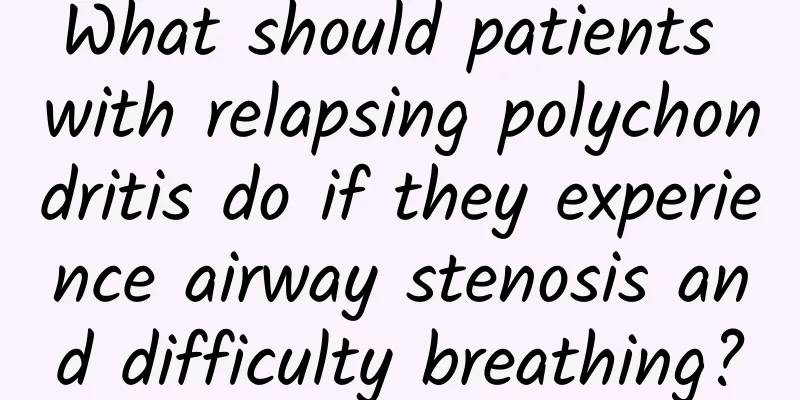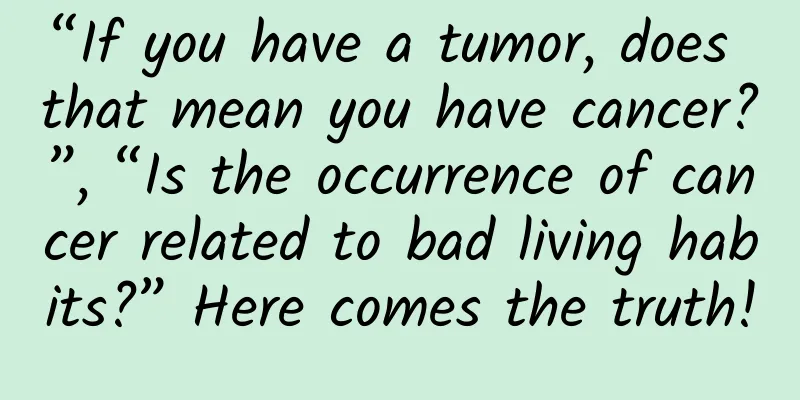What should patients with relapsing polychondritis do if they experience airway stenosis and difficulty breathing?

|
Author: Wang Guangfa, Chief Physician, Peking University First Hospital Reviewer: Wang Lixiang, Chief Physician, Third Medical Center, PLA General Hospital The 10th Chairman of the Science Popularization Branch of the Chinese Medical Association Relapsing polychondritis can affect a wide range of areas. For example, if it affects the nasal cartilage, it can cause the bridge of the nose to collapse; if it affects the ear cartilage, it can cause auricular deformity; if it affects the airway cartilage, it can cause airway narrowing and breathing difficulties, which are often fatal. When patients with relapsing polychondritis develop airway stenosis, the treatment method should be selected based on the patient's specific situation. For dynamic stenosis, when inhaling, the airway in the chest cavity can open, and when exhaling, the airway is compressed. Such patients can consider using a ventilator for treatment. That is, give him positive pressure ventilation, especially when sleeping, a little positive pressure, it will open, and after opening, the patient's breathing resistance will be reduced. So it helps to improve the patient's symptoms of dyspnea. Figure 1 Original copyright image, no permission to reprint Some patients may have carbon dioxide retention due to excessive airway narrowing, because the blood should discharge carbon dioxide into the alveoli, and the alveoli discharge carbon dioxide through ventilation. However, due to airway narrowing, the blood can transport carbon dioxide into the alveoli, but cannot discharge it from the body, resulting in high carbon dioxide in the alveoli, and then the carbon dioxide in the blood also increases accordingly. Therefore, mechanical ventilation treatment can be performed for such patients. Of course, for very severe airway stenosis, we are actually reluctant to choose the treatment method of airway stent. What are airway stents mainly used for? It is very severe airway stenosis, such as cartilage damage and deformation, in which case the airway can be very hard; when the cartilage disappears and the airway is soft, stent placement is necessary. Figure 2 Original copyright image, no permission to reprint Depending on the location of the stenosis, different stents may be placed. For example, if the stenosis involves the trachea and the left and right main bronchus, a Y-shaped stent may be placed, and the placement process will be more complicated. If it is only in a single location, such as the left main bronchus, the right main bronchus, or the trachea, a straight stent can be placed. There are different types of bracket materials: One is a metal stent, which is a cylindrical structure formed by weaving metal wires. There are stainless steel and nickel-titanium alloys. Relatively speaking, nickel-titanium alloys have better tissue compatibility, elasticity, and fatigue resistance. Because after the stent is put in, it will be squeezed. We breathe every day, hundreds of thousands, hundreds of millions of times, this kind of squeezing may cause metal fatigue and breakage. So relatively speaking, nickel-titanium alloy stents are better and are not easy to break. Another type is silicone stents. What are the advantages of silicone materials? It is that it has better tissue compatibility, because for the airway, the stent is a foreign body, and placing a foreign body will cause rejection and granulation tissue hyperplasia. The airway is originally narrow, and the stent is placed to open it, but later because of the continuous hyperplasia of granulation tissue, we have to find a way to deal with the granulation tissue, which is something we are very reluctant to see. Silicone stents are relatively less likely to grow granulation tissue. If granulation tissue does grow, it grows at both ends of the stent. For doctors who perform respiratory endoscopy, it is relatively easy to handle. They just need to use a mirror to clean both ends. The granulation tissue of the metal stent may grow into the mesh and even wrap up the entire stent, which is relatively difficult to handle. Sometimes the stent must be removed, but it is also difficult to remove the metal stent. Therefore, we are reluctant to put in stents. For these patients, as long as the airway is not narrowed, their survival time can be very long. The longer the survival time, the greater the possibility of problems with the stent. Some patients have no choice but to have granulation tissue grow repeatedly after stent placement, or they cannot be placed at all. There are some treatment methods abroad, such as tracheal and bronchial shaping, which is to fix the airway from the outside so that the airway can open. However, this method is not very commonly used, the operation is relatively difficult, and the effect is not particularly certain. Another option is to do a tracheotomy. Tracheotomy is mainly to facilitate the drainage of sputum. If the airway is narrowed, as long as the sputum can be drained out and the airway resistance is reduced, the patient will feel more comfortable. However, tracheotomy is not very effective for patients with distal airway stenosis. We are also worried about a very unpleasant problem, that is, in addition to the stenosis of the left and right main bronchus, these patients also have stenosis of some thinner bronchi, lobar bronchi, and even segmental bronchi, which is difficult to solve with stents. The treatment of such patients is very difficult. So in general, if relapsing polychondritis involving the airway is treated early, it can be controlled quite satisfactorily. If it is treated too late, there really is not much better way. Stent treatment is a last resort, which may be a life-saving option for some patients, but it also brings more problems. |
<<: Emphysema has three major effects on breathing that cannot be ignored!
Recommend
Does third degree cervical erosion require surgery?
Nowadays, many women do not take care of their bo...
Don’t use random medications for oral ulcers. First, distinguish the severity of the condition.
Oral ulcer is a common oral mucosal disease in li...
An 8-year-old girl can’t see clearly at near or far distance. The doctor said: It’s not myopia, but hyperopia. There is something wrong with the ciliary muscle!
An 8-year-old girl had trouble seeing both near a...
How many days after the end of menstruation is the safe period?
In today's life, many women don't know mu...
What should I do if my menstrual period is too light?
Under normal circumstances, a woman's menstru...
Pregnant women with acne on their chins are pregnant with girls
In life, there are many misunderstandings. Many p...
What are the methods for women to detoxify and maintain beauty?
Everyone knows that women love beauty, but many w...
Flu is coming! Knowing the symptoms of flu and how to prevent it is important!
Influenza, the full name of which is influenza, i...
How to stir-fry spicy hot pot base? Why is the hot pot base not fragrant when stir-fried?
Different places have different customs. There ar...
How to maintain your uterus
Taking care of the skin can make us younger and m...
How to deal with odor during menstruation?
As we all know, women will have menstrual blood f...
Does Yasmin make you fat?
Nowadays, girls are paying more and more attentio...
Nursing Care of Patients Undergoing Operation for Diabetic Retinopathy
As people's living standards improve, the inc...
What are the symptoms of IUD downward movement? Pay attention to backache and abdominal pain
The IUD is a long-term contraceptive method and i...
How many minutes does an abortion take?
With the development of medicine, artificial abor...









